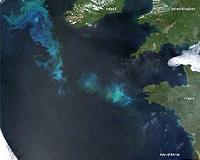| . |  |
. |
Washington DC (SPX) Aug 19, 2010 The first flight of NASA's hurricane airborne research mission is scheduled to take off from Ft. Lauderdale, Fla., on Tuesday, Aug. 17. NASA's DC-8 research aircraft will be making a planned five-hour flight along the Gulf Coast from western Florida to Louisiana primarily as a practice run for the many scientific instruments aboard. Mission scientists, instrument teams, flight crew and support personnel gathered in Fort Lauderdale this weekend to begin planning the six-week Genesis and Rapid Intensification Processes mission, or GRIP. NASA's DC-8, the largest of NASA's three aircraft taking part in the mission, is based at the Fort Lauderdale airport. The two other aircraft - the WB-57 based in Houston and the autonomous Global Hawk flying out of southern California - will join the campaign in about a week. The target for Tuesday's "shakedown" flight is the remnants of Tropical Depression 5, a poorly organized storm system whose center is currently hugging the coasts of Mississippi and Louisiana and moving westward. While forecasters do not expect this storm system to strengthen significantly before it reaches landfall in Louisiana, the system offers the DC-8's seven instrument teams an opportunity to try out their equipment on possible convective storms. Rainfall rates, wind speed and direction below the airplane to the surface, cloud droplet sizes, and aerosol particle sizes are just some of the information that these instruments will collect. GRIP science team members and project managers are now meeting daily at the airport to review weather forecasts and plan upcoming flights with their counterparts in two other airborne hurricane research missions sponsored by the National Atmospheric and Oceanic Administration (NOAA) and the National Science Foundation. Instrument teams are also working on their equipment onboard the DC-8 in preparation for the flight. On Sunday, Aug. 15, NASA's Global Hawk completed a successful test flight over NASA's Dryden Flight Research Center in Edwards, Calif., that took the remotely piloted plane to an altitude of 60,000 feet. The last of three instruments being mounted on the Global Hawk for GRIP is being installed this week.
Share This Article With Planet Earth
Related Links NASA Bringing Order To A World Of Disasters When the Earth Quakes A world of storm and tempest
 Hurricane formation linked to sea color: study
Hurricane formation linked to sea color: studyWashington (AFP) Aug 15, 2010 A change in the color of the ocean could dramatically impact the number and intensity of hurricanes, according to US researchers. A team of researchers with National Oceanic and Atmospheric Administration (NOAA) ran computer simulations of such a change in the North Pacific, a region that accounts for more than half the world's hurricane-force winds. The main factor is the green tint oce ... read more |
|
| The content herein, unless otherwise known to be public domain, are Copyright 1995-2010 - SpaceDaily. AFP and UPI Wire Stories are copyright Agence France-Presse and United Press International. ESA Portal Reports are copyright European Space Agency. All NASA sourced material is public domain. Additional copyrights may apply in whole or part to other bona fide parties. Advertising does not imply endorsement,agreement or approval of any opinions, statements or information provided by SpaceDaily on any Web page published or hosted by SpaceDaily. Privacy Statement |